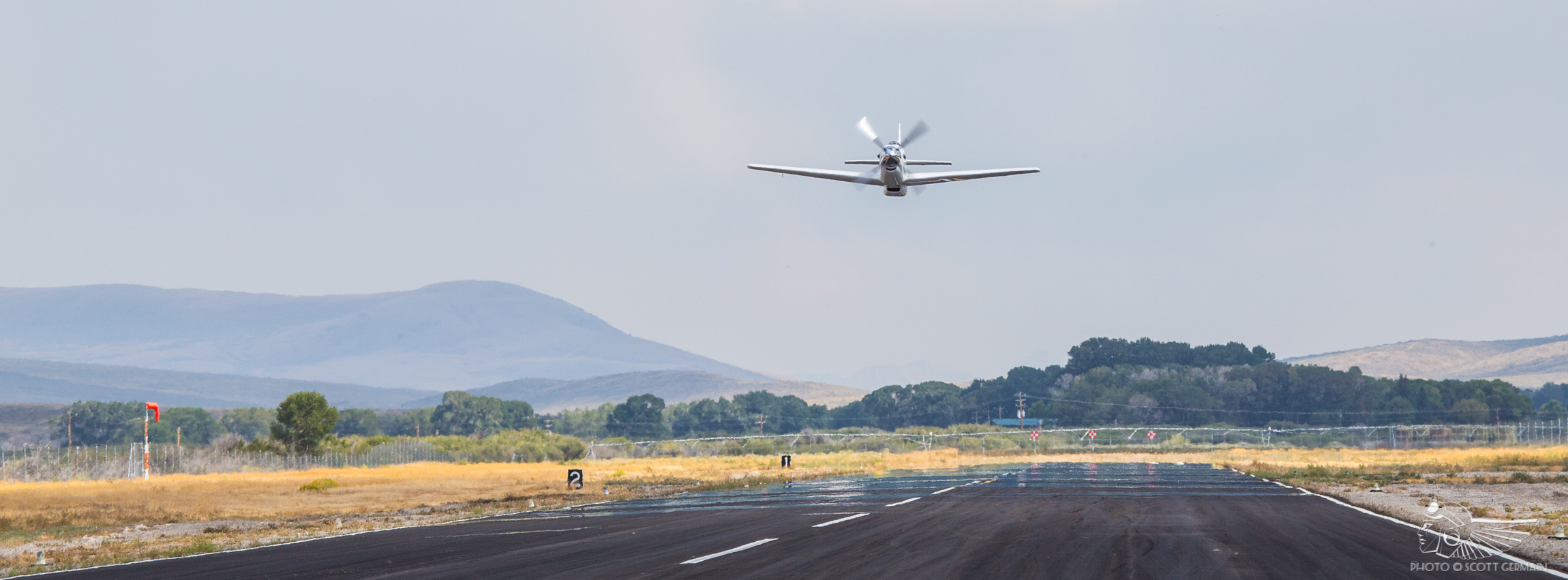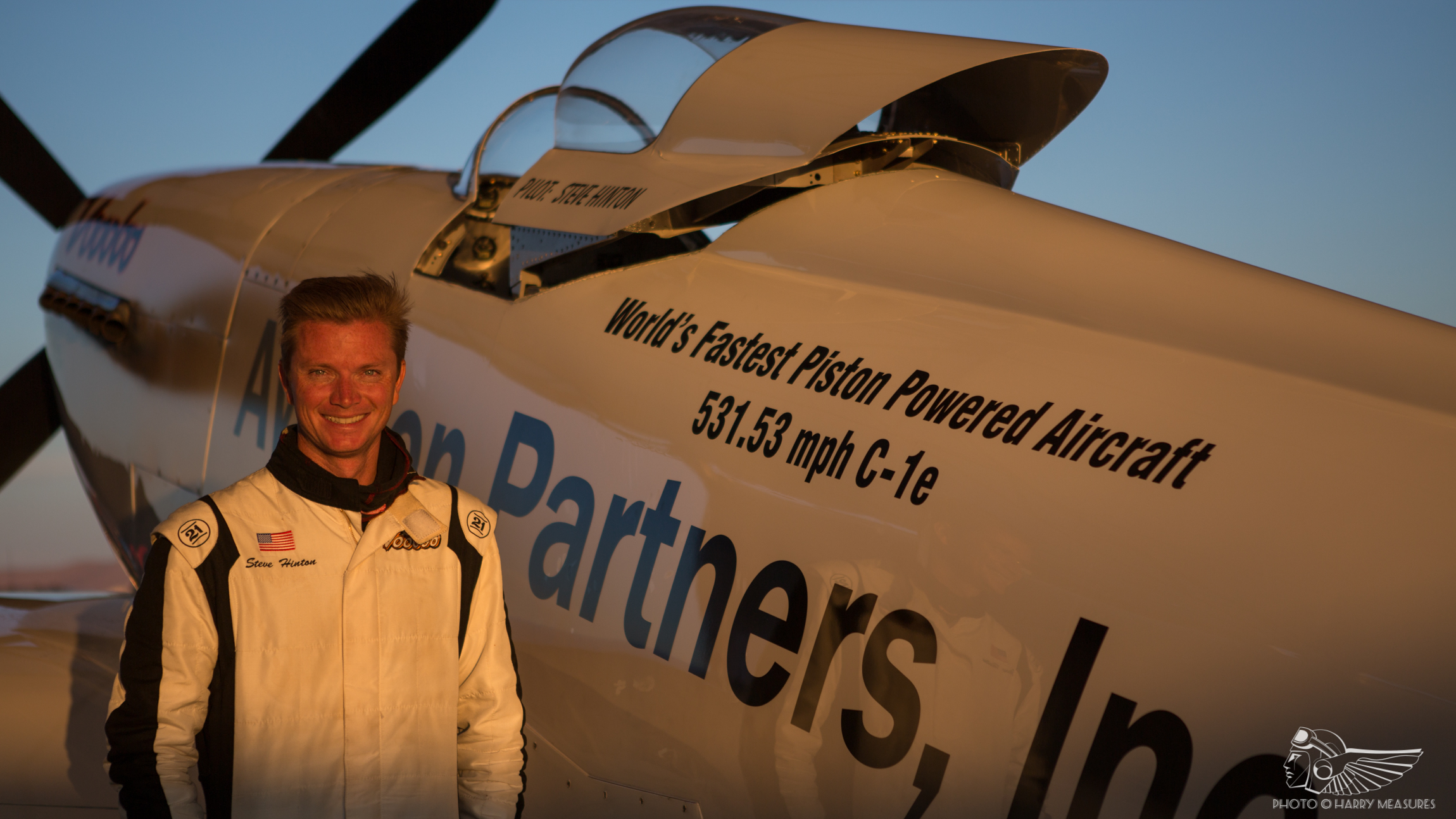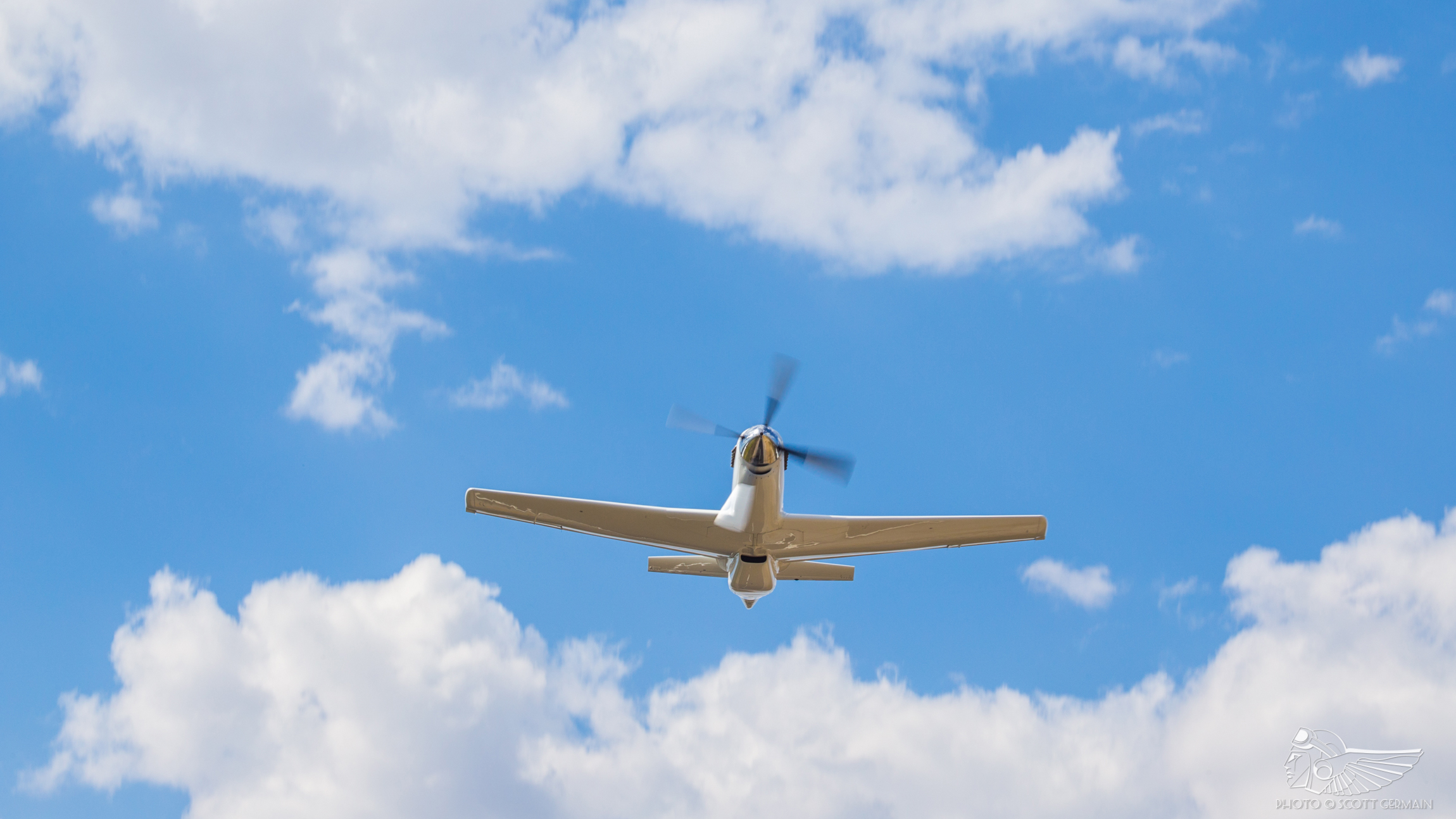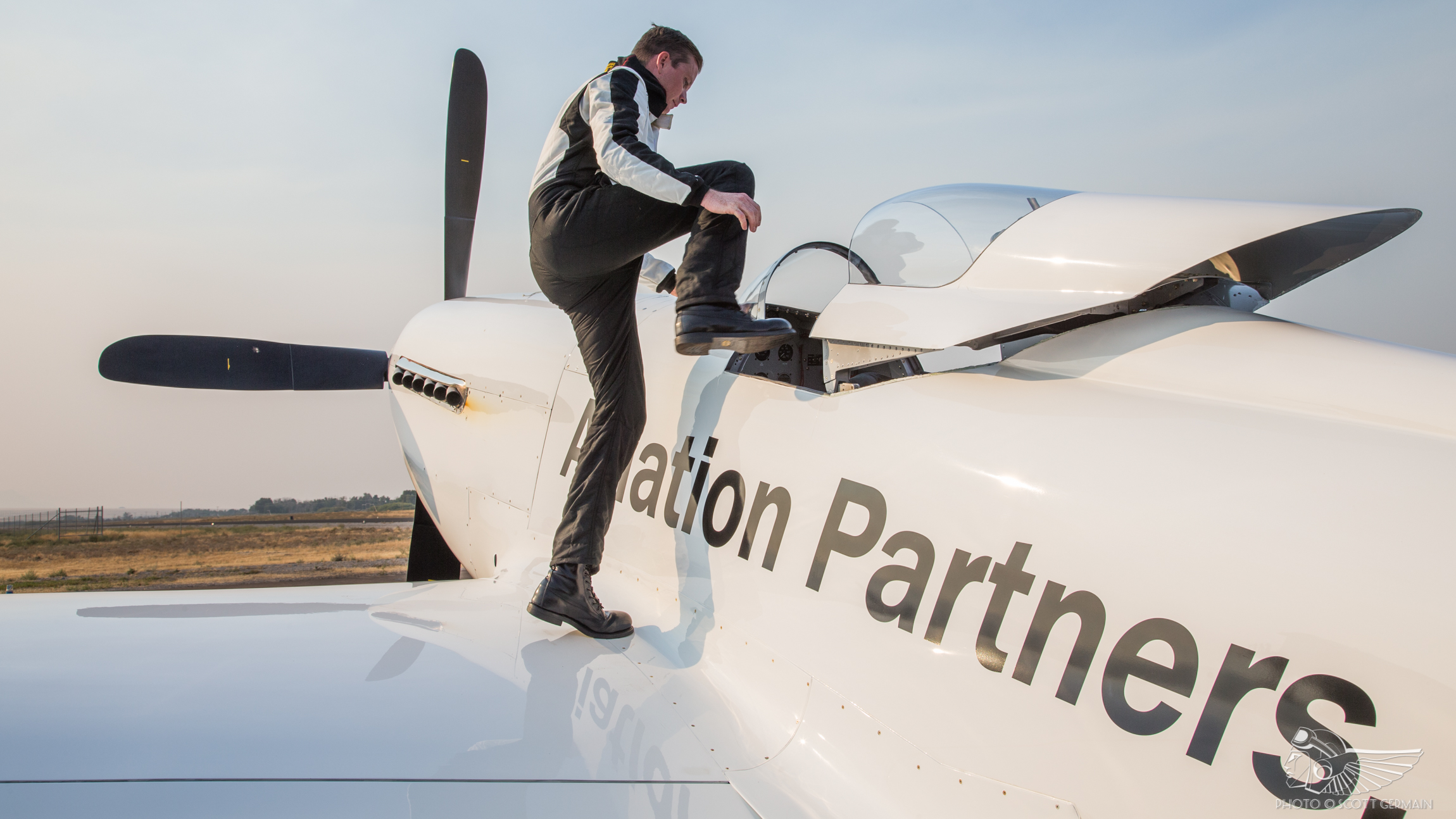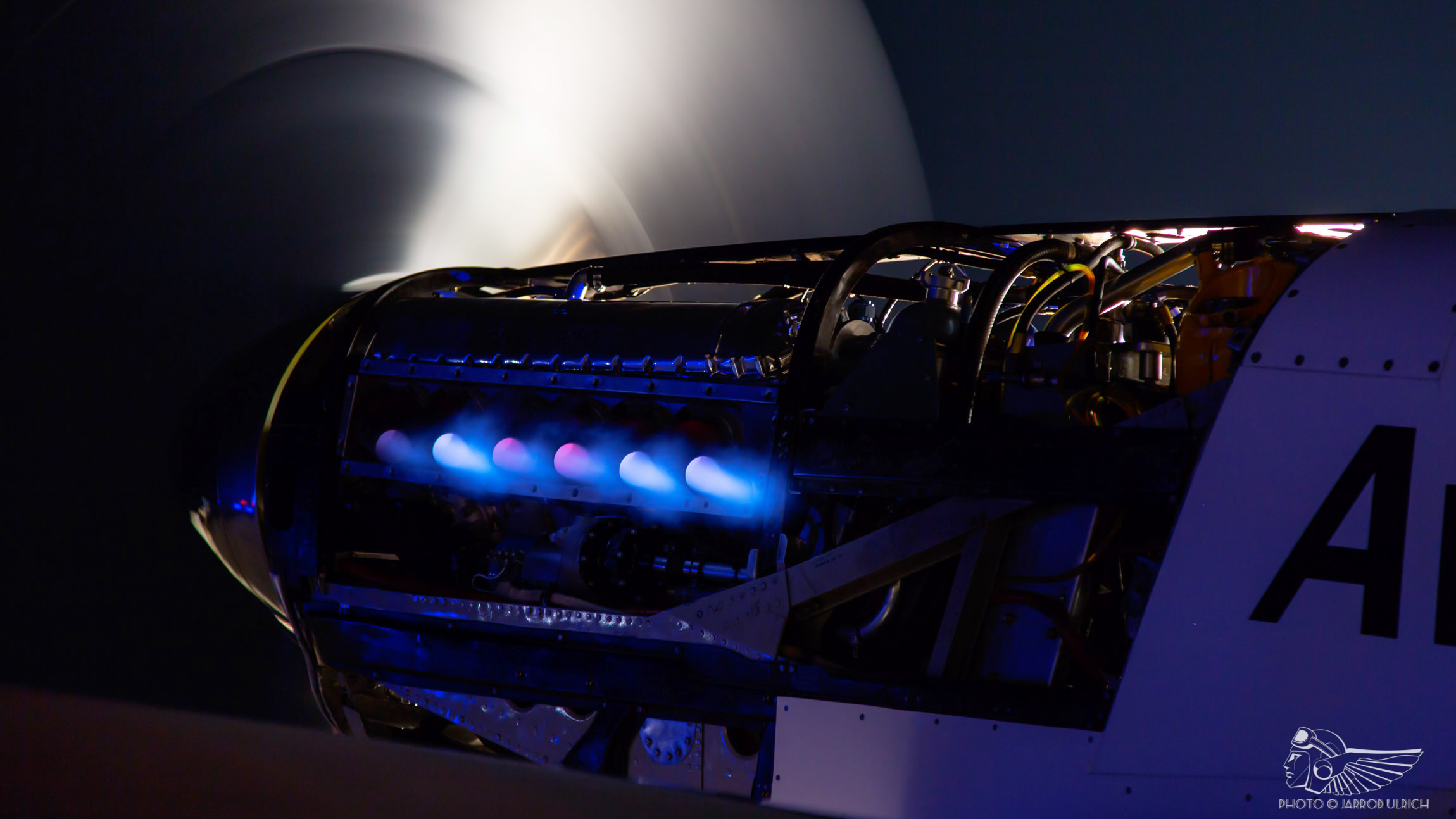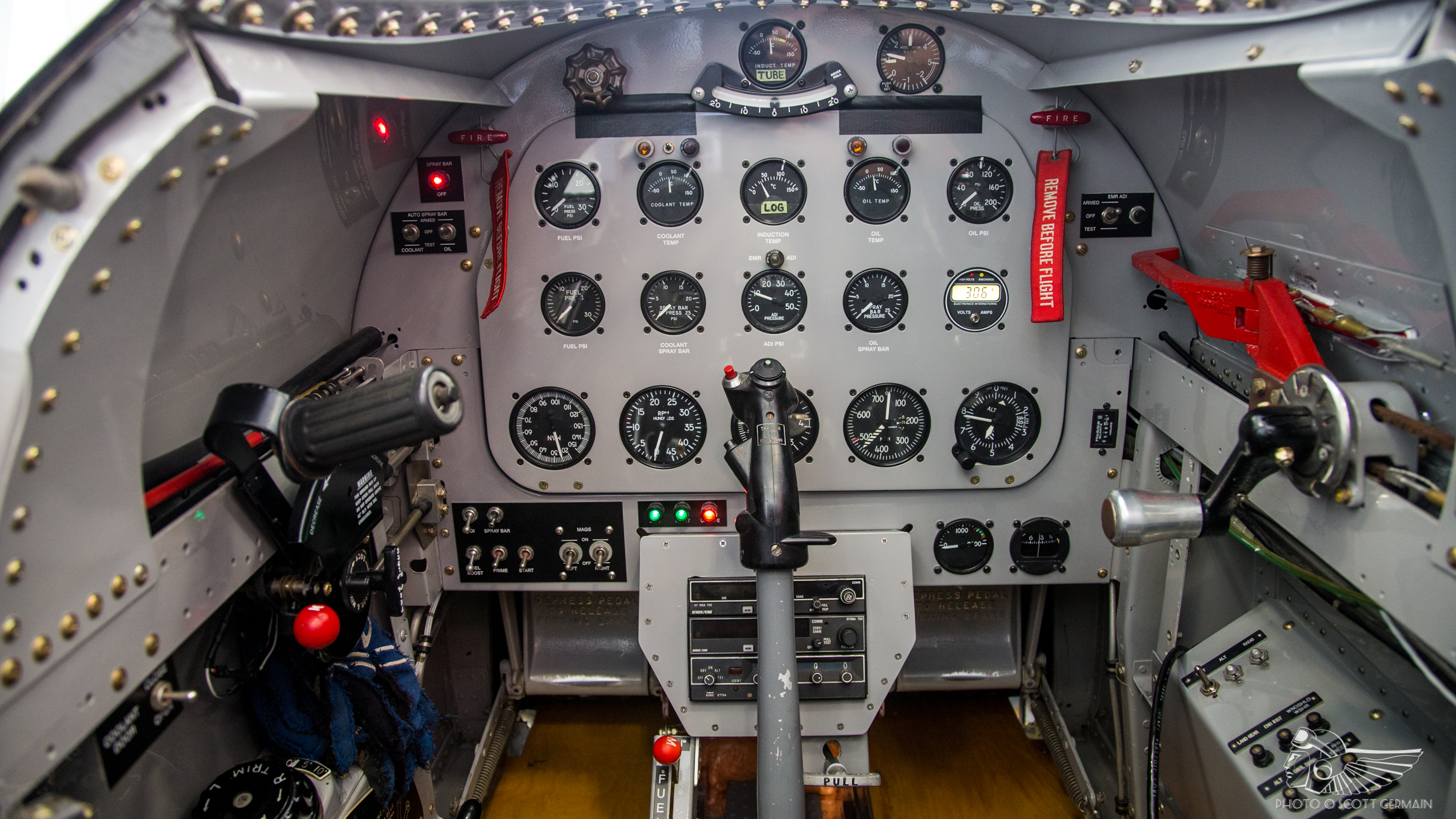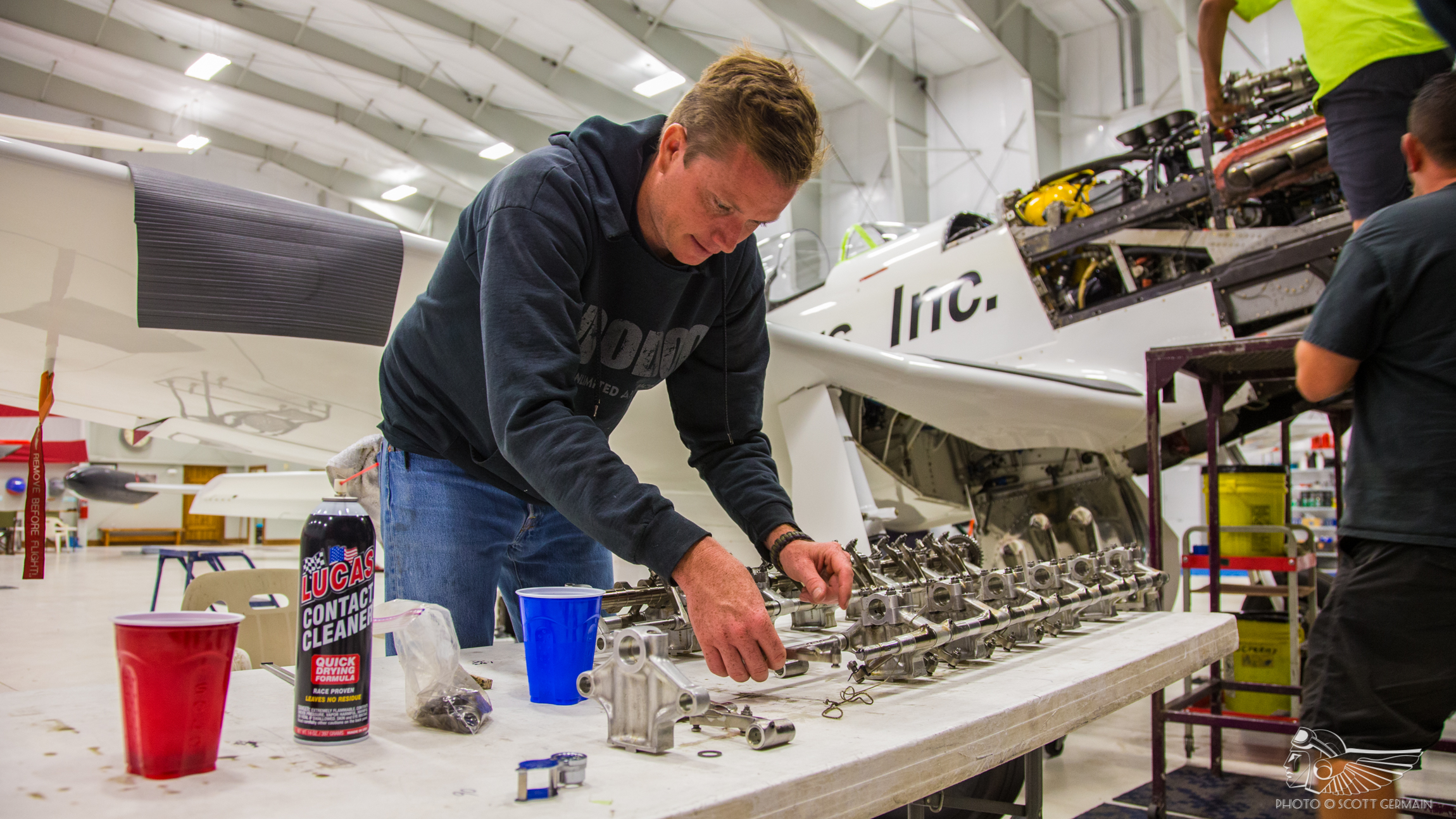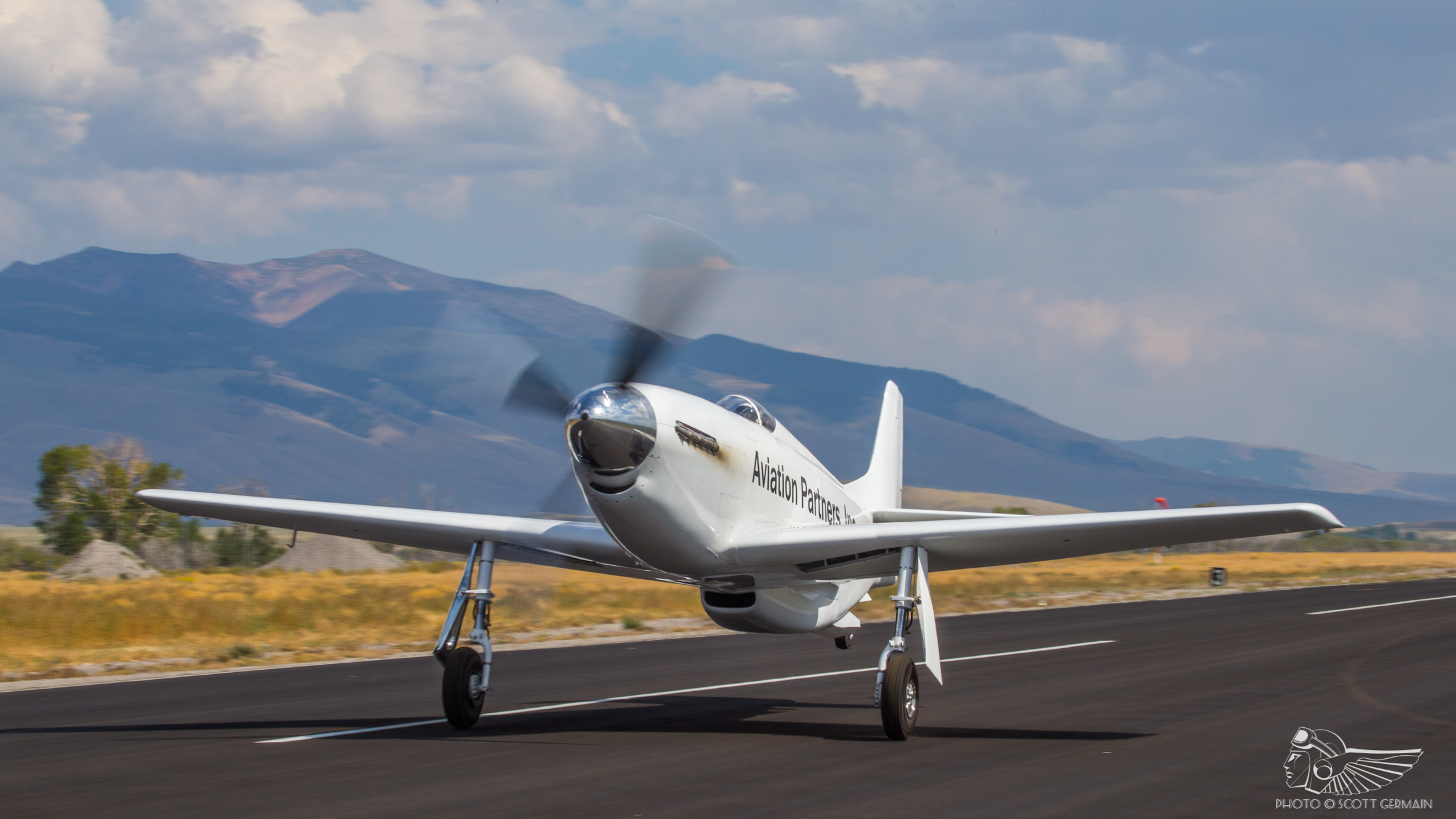On 2 September 2017, Steve Hinton, Jr set a new 3km Absolute Propeller Driven Piston Powered Aircraft (C-1e class) record, achieving an average speed of 531.53mph over four consecutive passes in highly modified P-51 Mustang Voodoo. Interviewed shortly after the record was set, and in the days leading up to his participation in the 2017 Reno Air Races, Steve offers The Vintage Aviation Echo a fascinating account of his record-breaking run.
The record to beat was a conservative 318mph, set in 2012 by Will Whiteside flying Yak-3 Steadfast. Though Steve would need to best this in order to claim the current record, the team ambitiously set their sights on breaking the retired iteration of the same record, set at 528mph by Lyle Shelton flying Rare Bear in 1989; regardless of the fact that this would not be formally recognised, Steve and the Voodoo crew pressed on with their attempt to top both formal and retired speed records in the spirit of competition. This has been subject to considerable controversy over the past few weeks, predominantly stemming from confusion over exactly which record has been set.
To better understand the scenario, it’s worth considering the conditions of both retired and current speed records. One of the main reasons for the retirement of the old record, and the one which would have the most impact for Steve’s attempt, was an increase in the corridor width. Previously the width of the course between the speed traps was a challenging 100m (330ft), now increased to 500m (1640ft) under the terms of the current record. In order to closely replicate the conditions of the retired record, Steve decided to fly the older, narrower course – his flying so accurate in the event, he passed through an air corridor just 30m wide on each of his four high-speed runs. A further change to the record was to break it down into weight classes. The old record had stagnated somewhat, with the record unchanged since it was set by Rare Bear, and so allowing lighter classes of aircraft to contest their own records made the sport accessible for more pilots. The weight class Steve would be contesting was the C-1e class, for aircraft with a take-off weight of between 3000 and 6000kg – the same class that Rare Bear would have fallen into had it been weighed at the time of its 1989 attempt. Under these new conditions, Will Whiteside captured the current C-1e record at 318mph in Steadfast in 2012.
Voodoo, the aircraft Steve used for the record attempt, is a heavily modified Mustang – those familiar with the Reno Air Races will know the aircraft as the (previously) colourful purple racer owned by Bob Button. Everything on the aircraft is geared for speed – even the paint, with the famed purple scheme lost and plain white paint applied as a weight-saving measure in preparation for the record attempt. As per a standard Mustang, Voodoo is powered by a Rolls-Royce Merlin – but this is no ordinary Merlin. Steve explains that a number of major modifications were made to the engine to improve performance, starting with the fitment of Allison conrods. This is a common modification for race Merlins, as at the high boost settings – also referred to as manifold pressure and noted in inches (“) of Mercury – used on racing engines, original Merlin conrods are susceptible to bending, often leading to detonation of the engine and the conrod ending up outside the case. If you were to directly compare both the Allison and Merlin components, you’d see the Allison conrods have considerably more material and structure to them, and so bear the higher stresses of a racing engine far better. With both engines sharing the same 6” stroke, the parts are almost a straight swap, the Allison conrods fitting to the Merlin crankshaft with the use of adaptor shells.
One of the numerous changes made in order to gain more manifold pressure is the fitment of a different supercharger impeller. Replacing the original is the component from a V-1650-23 Packard Merlin, originally fitted to the P-82 Twin Mustang – only a handful of these were made due to the limited production run of the P-82. The reason for the fitment of the -23 impeller wheels is that more advanced turbine technology was incorporated into the design of the turning vanes which, due to their higher efficiency, will usually provide an increase of around 10” of manifold pressure. At the other end of the engine, a slow-turning transport nose case has been fitted in place of the original. These gearboxes have a lower ratio than the standard item, .420/1, compared to the stock ratio of .479/1, giving a propeller RPM of 1428 at the engine’s maximum of 3400RPM – a reduction of 200RPM for the same engine speed when compared to the original nose case. This modification negates the increase of engine RPM found in a race engine, which is needed as the blades become less efficient as the tips approach supersonic speeds.
An additional system incorporated into Voodoo to eek even more power from the Merlin is ADI (anti-detonant injection). This system is fitted in place of the aftercooler normally found in a Mustang, the loss of which will gain a further 5″ of manifold pressure due to smoothing out the intake routing. The ADI system does the job of cooling the compressed intake flow by injecting a 50/50 mix of distilled water and methanol into the fuel/air mixture as it leaves the supercharger, prior to entering the combustion chamber. As an interesting aside, Steve notes that looking back on the history of the record since the Me 209 captured it in 1939, every aircraft to subsequently best it had an engine displacement of 34L (the capacity of the DB601 that powered the Me209) or greater; Daryl Greenermayer in the Bearcat, Conquest 1, powered by an R-2800 of 46L, Steve Hinton Sr in Red Baron, a Griffon-powered Mustang at 36.7L, and finally Lyle Shelton with the R-3350 powered Bearcat, Rare Bear, at 55L. Steve muses, “and here we are with the Merlin at 1650 cubic inches (27L), it’s significantly less – which I thought was very interesting as it shows how hard we are running the equipment to try and attain the speeds.”
Of course, many of those modifications were present prior to the preparation for the speed run, with Voodoo having been a competitive Reno racer for over two decades. One major change made purely with the speed record attempt in mind, however, was a major re-profiling of the wing. Using the full might of the main sponsor, Aviation Partners, Inc, and what Steve describes as “the most revolutionary technology that’s ever been applied to a racer”, the team were able to use computational fluid dynamics to model the new wing profile, and CNC machine the new components. The new wing profile is instantly recognisable to anyone familiar with Mustangs, especially when the flaps are down and the full extent of the work is evident. Another piece of cutting edge technology fitted for the run was live telemetry, allowing a second pair of eyes to monitor the Mustang’s critical systems – those eyes being Bernie Vasquez, a hugely experienced warbird pilot in his own right, and one of the current Texas Flying Legends aircrew.
Last year the team had Bernie qualify at Reno’s Pylon Racing School flying Voodoo in order to gain an insight as to how the aircraft performs in the race environment, and to really bed an understanding of the systems. Steve mentions that although the telemetry system is very useful, there is a slight lag in the telemetry data making it back to the ground. What this means is that in the majority of instances, Steve has already seen a potential problem arising in the cockpit and is making the correction as it is called for by Bernie. Still, it is helpful to have that level of oversight and it kept anything from going unnoticed during the record attempt.
Indeed, the cockpit layout itself was key to ensuring Steve was on top of any issues arising during the flights. Having built a new instrument panel over the summer, he explains; “It’s laid out specifically for racing, with important gauges such as induction temperature, oil pressure and temperature and coolant temperature front and centre. All of the flight instruments – altimeter, airspeed, RPM and manifold pressure – are down low”. Despite the changes to the panel, the cockpit itself is not a radical departure from standard, with the trim, gear and flaps to be found on the left and kill switches on the right. Of course, with the extra systems on Voodoo there are a few extra knobs either side of the instrument panel to further differentiate it from a stock Mustang, but, “you would climb in it and think, yes, this is a P-51.” The team waited for ideal conditions for the record attempt, the desire being to carry out the runs in as hot a temperature as possible in order to increase the density altitude. On the day of the attempt, the temperature reached 91°F (32°C), which pushed the density altitude up towards 10000ft. “At 91°F on the ramp, you get into the airplane with no air vents, coolant pipes running beneath your legs, and the engine right in front of you… It’s 130-140°F (54-60°C) in the cockpit, so it’s taxing that way, and mentally you’re that focused it’s… interesting!”
The modified Mustang’s structure threw up its own unique challenges during the preparatory phase in the days leading up to the record attempt itself. The view from Voodoo’s turtle deck canopy is quite limited, so in order to really learn the lines needed to fly the course, Steve took to a standard Mustang to establish points of reference he would later rely on during the record attempt – “you can go out for an hour, two hours, droning around and not hurting anything; of course you’re only going at 250mph, but you get the landmarks”. As well as the Mustang, Steve also (rather remarkably) flew the course in a Tigercat – a fairly unusual type conversion – with Stu Dawson in the back of Joe Clarke’s dual control example. When it came to flying Voodoo around the course, the view from the turtle deck canopy was so impaired that it necessitated flying the course at a conservative power setting of 60” in order to get the site picture, before really starting with the higher speed practice runs.
The first practice at speed was to cover just 40% of the overall distance of the full attempt, comprising of the dive in, first pass and reversal, then pulling off the course after the second pass. As well as enabling Steve to get some practice of flying the course at full speed, the team also wanted to use it as a benchmark to work out exactly how much of each fluid would be required for the full run. With the ADI tank only holding 42 gallons, Steve would have to be somewhat frugal with it – if he used the same set up as at Reno, he would run out. The spray bar water tank has a capacity of 104 gallons, which would be plenty for the attempt. This left the fuel, which Steve anticipated to be the least concerning of the trio, with a capacity of 147 gallons.
Following the first practice the team noticed particularly dark exhaust staining, however on initial inspection the engine seemed in good health. It was not until they drained the fuel tank the following morning that they found only 55 gallons of fuel remaining – the rich-running Merlin had consumed roughly 57 gallons of fuel, which, Steve mentions, is more than an R4360 would have been expected to burn, by way of comparison. Running the numbers, they realised that had the full course been flown, Steve would have only had eight gallons remaining after landing. This was rather alarming, and necessitated the fitment of a new carburettor. To further put this into context, with the new (and correctly performing carburettor), 54 gallons of fuel was used for the full distance attempt.
Another of the key things that the practice runs helped to prove out was the dive profile – a somewhat contentious point, mainly due to the ambiguous wording of the rules from the Federation Aeronautique Internationale (FAI), which state that once the flight performance begins, you cannot exceed 500m (1640ft). “That in itself is a very grey area – does the flight performance include take-off? I called [the FAI] and asked that question”. The answer was that it begins the first time that the aircraft crosses the entry gate onto the course, although Steve clarifies, “That rule has not changed; people argue about it, but through the National Aeronautical Association’s Rulebook it has been consistent – no one took advantage of that”. For the practice attempt, the run-in was entered from 3000ft AGL (above ground level), which gave a first pass of 540mph. Later attempts would use more height to edge the initial speed even higher.
When flying the record attempts, there is a strict altitude limit of 1500ft imposed during the turnarounds and even here, the speeds the aircraft reached created unforeseen problems. The practice runs uncovered that the instruments on the static system (airspeed indicator, altimeter and vertical speed indicator) would begin to read erratically as Steve climbed in the turns. Passing through 1300ft, the altimeter would start swinging 400-500ft in either direction, which, with the hard cap at 1500ft, was not ideal, especially for something so critical to the success of the attempt. An idea to use spotter aircraft circling at 1500ft was put forward, but given the somewhat hazy conditions on the day of the attempt (due to the local forest fires, the visibility was between 5 to 6 miles) Steve erred on the side of caution. In explaining the decision, it’s clear it was safety driven – “I didn’t want to get into a scenario where I couldn’t find them [the spotter aircraft], and be more worried about trying to find traffic than focus on the instruments”. Of course, this would lead to sacrificing some performance by capping height in the turns to 1300ft (or thereabouts!), giving a slightly shallower dive back into the course than originally hoped for.
With the recce and practice runs completed, the team could think about going after the record for real. As well as the defined course itself, Steve had a prescribed climb and entry procedure to follow. Shooting off a list of power settings and waypoints, he explains that on take-off, the standard Mustang power settings of 60”/3000RPM would be used, prior to settling into a right turn – purely to line up with a nearby road, to be utilised should the engine fail on climb out. Satisfied with the engine performance and climb rate, Steve would enter a sweeping, left hand climbing turn, bringing him downwind of the airfield before pushing the power up to 80”/3400RPM. Entering the turn back toward the course, and at peak altitude of 6000ft AGL, the power would be further increased to 100”, and, once lined up onto the entry gate, full throttle would be applied, opening the Merlin up to a monstrous 111”, which increased further to around 120” as the altitude bled off.
To put these numbers somewhat into perspective, Steve also detailed the power settings that are commonly used on stock Mustangs during a race at Reno. For the first half lap or so, following release from the pace aircraft, take-off power would be used – that being 60”/3000 – before pulling back to the METO (Maximum except for takeoff) power setting, which, on a standard Mustang is 46”/2700RPM. Even then, the aircraft won’t cool very well so the fitment of a water spray bar (to cool the radiator) is common. A further reduction of power to 42″/2400RPM might also be on the cards as the race develops, although, Steve chuckles; “Some guys will run 60 inches for a whole race, but that’s kinda like, what for?!” Even at 60″, it is unlikely a stock Mustang would catch the more powerful types that normally occupy the rift between the slower types like the stock Mustangs and the higher echelons of the Unlimited class, such as Sea Furies and Tigercats.
Airborne and pointed at the runway some 10 miles out, with Voodoo’s Merlin screaming away at 111” and 3400RPM, Steve then had the small task of actually hitting the entry gate. “You’re trying to hit this postage stamp at your peak speed… it’s all geometry… you hit the entry gate at 100ft AGL and then maintain that through the timing clocks”. The timing clocks are, as you might have guessed, 3km apart, so at peak speed the timed section of the course would flash by in little over 12 seconds. From there, Steve would enter a huge turn around to bring him back to the runway but, when pulling only 2.5G (to avoid bleeding speed at higher G loadings) at the kinds of speeds Voodoo was reaching, the turn radius balloons to roughly 12000ft. The course itself was huge, with the turn taking him seven miles from the runway.
On the first attempt, having climbed to height and with the entry gate in sight, Steve started to push the power up. Everything seemed to be running well. 111″ manifold pressure was attained, and the engine instruments were all good, however, it soon went very wrong, very quickly. Steve recalls; “The power was on for about ten seconds… all the Ts&Ps [temperatures and pressures] were OK”. Then, all of a sudden, “there was a VWOOOP….BOOM! A lot of debris came out the exhaust stacks, white smoke, that kinda stuff, so very quickly I pitched the aeroplane up to get more altitude, and ended up at about 7000ft”. Declaring an emergency, Steve began pulling the power back and shutting down the additional systems. Mercifully, at cruise power (36″/2300RPM) the engine began running somewhat smoothly. When in this situation, comparing the Ranch to Reno Stead, Steve notes there is an obvious drawback to the Ranch. “The runway is 75ft wide – it’s very narrow, and it’s one direction. Reno is nice because the runways are so large, and there are three of them, so from anywhere on the course you can land.”
Once safely back on the ground, a compression check exposed the B bank had failed – or more precisely, a valve seat – causing a backfire. Flown back to the engine builders, Vintage V12s, the bank was repaired in a day and a half, with five bent valves found in the process. Steve grins, “it was just atrocious!” After refitting the freshly overhauled bank, Steve flew a few hours in Voodoo purely to bed it in, before climbing up to altitude and taking the engine up to 100″ purely to check it would take the power. Voodoo was back in the game, and so Steve took to the cockpit once more for the attempt.
The first pass was 554.69mph, a truly phenomenal speed. Reciting the number, Steve grins – how could you not? “[It was] just smokin’- not literally smoking, well, not yet, anyway – just haulin’ ass!”. The second pass came in at 527.34mph, and with that a report of oil bleeding from the aircraft, its Merlin already beginning to falter. Passing through the clocks a third time, there was a slight increase of speed to 528.48mph. This was good – perhaps the engine might last after all? Perhaps not. Steve recalls; “Going into the fourth pass, [I was] just out of the gates, and the oil pressure fell from 120lbs/sq in to 70lbs/sq in. At Reno, if you saw something like that you’d declare a mayday”. This left Steve with a very difficult decision to make, and make quickly. Having flown only three passes, abandoning the run now would disqualify the whole attempt. He needed that last pass.
“Instead of going out seven miles and going away from the airport – which is a sanctuary, the only good thing [in this situation] – I decided I’d turn it around in three miles. I pulled 4.5g in a left hand turn to get back to the airport, and it lived long enough to get through and at least get a time.” The last pass was 515.62mph, the ailing engine clearly showing it was on the way out. “I immediately pulled off into the downwind, coming back on the power and the engine just started losing the will to live – shaking, rumbling, running really rough. I started moving the throttle seeing if there was any power and you’d go half on the power and the RPM would surge up to 3000 – it was just going bonkers!”. Once again, Steve bought Voodoo in for an emergency landing, the troublesome B bank the cause – nearly all of the oil had been thrown overboard, leaving just four gallons in the tank out of the original 11. The flight had lasted 17 minutes and 18 seconds, with the now expired Merlin having been at full throttle for eight minutes and 52 seconds; but had it been enough to capture the record?
The four passes averaged at 531.53mph, smashing the existing record of 318mph by well over 200mph. There was, however, a catch. The team’s goal had been to break the retired Shelton-held equivalent record. In order to officially break any record, it has to be beaten by at least 1% – hence the target speed being 534mph, 1% over Shelton’s 528mph. It’s a tricky subject to broach but Steve, ever the sportsman, addresses it with candour. “It’s a shame the [Shelton] record was retired. Records are meant to be broken. When records are retired they are essentially unobtainable, and our goal was to break his record. It’s a catch 22 – if we broke his record, everybody would have said, well it doesn’t count as his record’s retired, and we didn’t break his record by the prescribed 1%, which doesn’t matter as it’s not attainable anyway… It’s a lose-lose scenario”. Still, that’s not to knock what the team have achieved. Five hundred and thirty one miles per hour – it’s a tremendous speed, and certainly enough to keep the owner, Bob Button excited, as well as Joe Clarke of Aviation Partners, Inc, so there are hopes to have another attempt next year, and set the bar even higher.
Reflecting on the trials and tribulations of the record attempt, and drawing as firm a conclusion as possible on the team’s efforts to enter the history books, Steve quite rightly points out the reality of the situation. “The fact of the matter is that it is the fastest piston-powered aircraft ever [officially recorded by the FAI] at 531mph. You can’t argue with it. 531 is greater than 528.”
With many thanks to Steve Hinton and the whole Voodoo team for facilitating this interview during a very busy Reno week, also to both Scott Germain and Jarrod Ulrich for their comprehensive stills coverage. Credit to Pursuit Aviation for their stunning aerial cinematography, provided by their state of the art camera system developed in partnership with SHOTOVER, mounting the groundbreaking 6-axis gyro stabilised F1 camera system to a T-33, allowing the capture of fully stabilised imagery at over 350 knots and under heavy G-loading.
![]()


